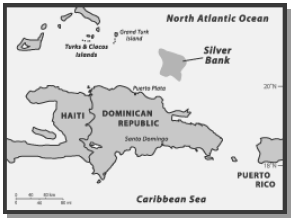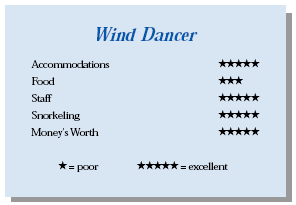Humpbacks of the Silver BankContents of this Issue: Hurricane Season: Bad News and Good News Bought your gear online? Get out of my class! The Role of Regulators in Diving Incidents The Skinny on Wet Suit Shrinkage Editorial Office: Ben Davison Publisher and Editor Undercurrent 3020 Bridgeway, Suite 102 Sausalito, CA 94965 a special Caribbean trip from the July, 2003 issue of Undercurrent
Dear Fellow Diver: "Son of a breach!" I couldn't imagine spending six days at sea just snorkeling with humpback whales. An intrepid diver for more than two decades, I've jet-lagged my way around the world for close encounters with sharks and sea snakes, mating cuttlefish and colorful corals. How could I be happy without a regulator, decent depth, or a variety of creatures and reefs? Serendipitously, 10 years ago, I had a humpback encounter in the Turks and Caicos. Diving at 60 feet, my buddy stretched his arms. There was something big behind us. Assuming it was a shark, I was aghast when I saw a humpback headed our way. With our backs to the wall, I thought my time had come. The whale checked us out, then surfaced, breached, and returned. Thoughts of Jonah being swallowed rushed through my head. The whale stopped next to us giving me a close up of its barnacle-covered pectoral fins before swimming off. I was hooked on whales. No one can sell a trip better than hyper-enthusiastic Marc Bernardi of Aquatic Encounters. Each year Marc books trips between mid-February and early April when whale expert Tom Conlin, owner of Aquatic Adventures, contracts with Peter Hughes' Wind Dancer. Six months before the trip I learned there was one space left on two departures so I signed up. The Silver Bank was named for the Spanish galleon, Nuestra Senora de Conception, which sank in 1641 after colliding with towering coral heads submerged inches beneath the surface. She was carrying $40 million in silver bars. Today, as many as 5,000 Atlantic humpbacks migrate to the 20-mile bank of shallow water (less than 100 feet), 85- miles north of the Dominican Republic and a similar distance southeast of Grand Turk. It's a three-month sexual orgy. Everywhere whales are breaching, finning, or lob tailing as males solicit sex from females in estrus. Bulls, their testosterone off the scale, sing symphonies to attract females, even to those who are nursing calves. Each bull is focused on one goal: finding and copulating with an agreeable female. Females without calves depart the Bank pregnant. The whales are so consumed with sex they stop feeding. They emanate bird-like songs mingled with mournful groans and chirps and warbles as they court. Of all the tones, the closest resembles that of a cow. The background noise or "drum section" is the crackling of shrimp. Curiously, no one is known to have ever observed either the act of mating or birthing. Curbside at the Puerto Plata, Dominican Republic, airport, I learned that the Wind Dancer, Bottom Time, and Turks & Caicos Aggressor II had synchronized their departures to transfer all of us to the dock in one bus. We drove along the malecon (boardwalk) bordering the Atlantic shoreline, whizzing past a sculpture of Neptune on rocks offshore. Thirty minutes later the bus stopped at the Marina Muello Viejo, and we boarded our respective boats. It was late afternoon, and the Wind Dancer was not scheduled to depart until midnight for its 10-hour trip to the banks, so I deserted the ship to cab to the nearest sports bar to cheer on my UofA basketball team in March Madness. I missed the standard crew introductions, boat layout, safety procedures, rules, and dinner, but the game was worth it. At midnight, we departed at 10 knots on a calm night, awakening the next morning to find the ship moored at the Bank. The only landmark in sight was the rusted wreck of the freighter Polyxeni, its hull sitting on the fringing reef that defines the Northeast corner of the Silver bank. The Aggressor and Bottom Time were nearby. Tom Conlin has been studying whales on the Silver Bank for nearly two decades. In 1983, he wrote the guidelines for the Dominican Republic for observing the whales and obtained the first permit (of today's total of four). Three years later, the area was established as a whale sanctuary from December through mid-April each year. Tom calls the whales his "darlings" and cautioned that anyone who chased or threatened a whale would be asked to get out of the water. His goal is for everyone to leave the Banks wanting to help with the conservation of all whales. After breakfast, Tom gave us an introductory briefing. "It's been a good year. Our next lesson was in pointing out the location of a whale: the bow is 12 o'clock, and a whale might be "2 o'clock, 3 boat lengths away." Whales follow a pattern. When they sound they leave a fluke print. "We won't drop you into an aggressive, rowdy group or any fin slappers. Have good energy -- don't get pissed or moan, or so will we. ... It's like a Friday night happy hour at the rowdiest bar in town. ... By two in the morning there are only a few males left. ... This is the best bar in town." As many as fourteen males can compete for one female. Rowdy groups use their barnacle- covered dorsal fins to slash one another. Breachers crash in midair. To track the whales better, Tom and Brett used stopwatches to time the calves underwater. They surface every four to five minutes to breathe. Most of the youngsters are like kids in their "terrible twos." "The calves may be curious about us, but we need mom's permission. If a whale turns direction twice, we leave them alone. We always give them their space." My first experience was on the tender Challenger, captained by a South African and Wind Dancer Captain Brett Sussman and his mate Barcelonan David Gallardo. First I had to learn the "seal" entry. Lying on our bellies leaning over the gunwale with mask and fins on and cameras in hand, we eased into the water trying not to make a splash. Frequently a scout (one who could climb into the boat without the ladder) was sent to spot a whale that had just tailed down into the water. If the scout found the whale, he or she (only one woman could manage to hoist herself into the boat) raised her arm straight in the air, and we bailed and swam to "whale side." There was a tendency to score our scouts -- even our collegiate diver occasionally flopped his fins splashing the water. And some of us who got so excited that we sealed in without our fins having to make a fast retreat to the boat because of the current. Our most frequent encounters were with females and calves cuddling. Some lasted a few minutes, the longest was 15 minutes. We prowled the water snorkeling from two custom-built, 25-foot Privateer fiberglass tenders, the Escort and Challenger. With twin four-stroke, 50-horsepower engines and Bimini tops, they were lined with benches. Both the Aggressor and Bottom Time used Zodiacs without shade or the higher vantage view. Whenever we sighted a mother with calf (occasionally accompanied by a courting escort) we sealed into the water, hoping the whales would swim toward us. They told us to swim with our hips to the side, barely moving our fins. After a few encounters we sensed how to give the whales their "space" and not make them feel corralled. Each tender also had a divemaster/photographer who directed us in the water when not passing us water, fresh fruit, sandwiches, candy or cookies. At 8:30 each morning we boarded tenders, taking a break between 12 p.m. and 2 p.m. before we headed out for three hours each afternoon. Every day our group changed boats so we were alternately captained by Brett or Tom. Even when "whale waiting" seemed slow, there was exciting surface activity. Whales breached or a rowdy group, their dorsal fins bloodied from fighting to become the alpha male, might pass near the tender chasing a female and calf away from us. Several times Tom dropped hydrophones into the water so we could hear the whales' song. One morning the group on the Explorer had a dozen whale encounters and swam with half a dozen spotted dolphins, many with newborns. Their group included seven Southerners who privately jetted into Puerto Plata and pretty much hung together, a computer geek, and a single from Italy. The nine of us in the Challenger, which included seven Americans and a couple from Scotland, were satisfied with four immature rowdies, which for some unknown reason sometimes includes females, giving us a close up view of their bloody dorsal fins by swimming under our boat. Then we found a mom and calf being followed by a young male hoping to court her. Sealing into the water, we watched as they circled us rising to the surface. It was one of our best encounters. Another day, after following a mother and a calf, she turned radically twice, so Brett steered away. That was a signal the whale wasn't interested in us. Finding another female, we spent three hours with her. The calf played with and nuzzled its mother at a depth of 30 feet. After 15 minutes, Brett noted that the third time the baby surfaced for air, we wore out our welcome. The calf breached, missing us by a few feet. Then mom tail breached, slapping the water to tell us "enough." Divemaster Hoi Leung shouted for us to head for the boat and get out of the water. When the whales "settled" we again entered the water with them. This time the baby was nursing and snuggling quietly -- females nurse by releasing milk into water. The next time we entered the water the baby was upright as if standing on her tail. One afternoon we found a mom and calf with two escorts. The calf was a female (only observed by anatomical viewing of its hemispherical lobe); we were unable to determine the sex of the escorts. We assumed that one or both were males.
One doesn't need to be a scuba diver to join the trip, but it helps to be comfortable in the sea, a good swimmer, and reasonably fit. Good fins are a necessity for the current and avoiding the danger of a tail slap (several of us missed being hit with a tail by only a few yards). Six hours of continual sliding out of the tenders, swimming 100 yards quietly but quickly, then climbing up the ladder after many whale encounters can be exhausting. Water was a constant 78, but over time body temperature drops. Vis was about 30 to 50 feet with quite a bit of plankton plus cloudy skies -- poor conditions for photography. Apparently, these were atypical conditions -- the water is often a sapphire blue with a range of 50-plus feet. (I saw video and slides of this great water.) We did not have the rough seas with high winds that can occur in February and early March. Breakfast was a choice of a continental buffet or made to order. Lunch was a nondescript buffet. Dinners, which were unimaginative and mediocre, included soup (never served hot), an iceberg lettuce salad, a choice of two entrees, and dessert. One passenger was allergic to wheat and they satisfied his dietary needs. The trip included complimentary, self-service bar cocktail hour with nuts and occasionally fried appetizers. One lunch and one dinner were a topside barbecue. The lounge/dining room is comfortable and has an entertainment center with a CD, VCR, Hi-8mm player, and library. On our last day, we had about half a dozen quick fly-bys in the morning and only a few in the afternoon. Overall, we had a good week of encounters and calm waters, but cloudy skies and poor visibility. At some locations we snorkeled with schools of thimble jellyfish; fortunately none were in the stinging mode. Before heading back to the ship to return to Puerto Plata, we stopped to snorkel the wreck of the Polyxeni. What a different experience after viewing magnificent whales. Instead we were gazing down at nudibranches, tangs, and a couple of parrotfish. As Tom would say, "Oh, whale!" I couldn't have felt more enthusiastic about spending four and a half days in the water with the whales, but I had to spend a night in Miami for both the outgoing and return flight home. American Airlines operates only one flight daily to Puerto Plata that didn't allow me time to make connections. I welcomed not having to haul much more than fins, mask and snorkel, a couple of skins, and only a few clothes. I abandoned the heavy camera gear and film and traveled light with a new digital camera and Ikelite case. I didn't relish the thought of having to bunk with a roommate on a sold-out ship and dreaded the thought of getting stuck sleeping in the upper, smaller bunk. On Thursday, our final day of snorkeling, Tom gave us the choice of returning to Puerto Plata during the nighttime or traveling during the day Friday. Asking each of us privately, the group unanimously decided to depart that night. This allowed some of us to get home a day earlier even with a half-day tour of Puerto Plata. Those who had made plans to continue their stay in the Caribbean remained on the boat. Frankly, I would have preferred another day of snorkeling with the whales, but my vote was in the minority. Nonetheless, the trip was such fun. I didn't miss my regulator and BC once. And, of the three boats plying the banks, with Tom as the leader and shady chase boats, this is the one to take.
|

I want to get all the stories! Tell me how I can become an Undercurrent Online Member and get online access to all the articles of Undercurrent as well as thousands of first hand reports on dive operations world-wide
| Home | Online Members Area | My Account |
Login
|
Join
|
| Travel Index |
Dive Resort & Liveaboard Reviews
|
Featured Reports
|
Recent
Issues
|
Back Issues
|
|
Dive Gear
Index
|
Health/Safety Index
|
Environment & Misc.
Index
|
Seasonal Planner
|
Blogs
|
Free Articles
|
Book Picks
|
News
|
|
Special Offers
|
RSS
|
FAQ
|
About Us
|
Contact Us
|
Links
|
3020 Bridgeway, Ste 102, Sausalito, Ca 94965
All rights reserved.

 We've had lots of whale encounters.
This is my 130th week during
the past 16 years. Our first
encounter will probably be a 'fly-by'
so all of you can get your first whale
fix. It will be a 'blow and go,' a
whale surfacing and moving on." If we
were downwind, Tom advised us not to
breathe the mist from the blow. It's
smelly and oily and not good for camera
lenses.
We've had lots of whale encounters.
This is my 130th week during
the past 16 years. Our first
encounter will probably be a 'fly-by'
so all of you can get your first whale
fix. It will be a 'blow and go,' a
whale surfacing and moving on." If we
were downwind, Tom advised us not to
breathe the mist from the blow. It's
smelly and oily and not good for camera
lenses. The 120-foot Wind Dancer has
eight staterooms (sleeps 18) on the
lower deck, each with a double lower
bed and twin upper and a small private
bathroom with shower. There is an
owner's suite on the salon deck with a
queen bed, glassed-in shower and a
real window. Rooms vary marginally in
size. Our small cabin didn't have
enough room for us to pass one another.
To reach the upper bunk with my
short legs, I had to stack three pillows
on my roommate's bed. On most
live-aboard boats, I either roast or
freeze, but our little cabin, without
its own temperature control, was comfortable. It also had a mirrored cabinet with
sink, a closet with three drawers, a black-painted porthole with drape, a hair
dryer, bath amenities, and those signatures of Peter Hughes: blue terry robes and
morning coffee delivery, nightly turndown service with chocolate kisses on the pillows.
There was probably a crew of 10, and each was helpful and enthusiastic.
The 120-foot Wind Dancer has
eight staterooms (sleeps 18) on the
lower deck, each with a double lower
bed and twin upper and a small private
bathroom with shower. There is an
owner's suite on the salon deck with a
queen bed, glassed-in shower and a
real window. Rooms vary marginally in
size. Our small cabin didn't have
enough room for us to pass one another.
To reach the upper bunk with my
short legs, I had to stack three pillows
on my roommate's bed. On most
live-aboard boats, I either roast or
freeze, but our little cabin, without
its own temperature control, was comfortable. It also had a mirrored cabinet with
sink, a closet with three drawers, a black-painted porthole with drape, a hair
dryer, bath amenities, and those signatures of Peter Hughes: blue terry robes and
morning coffee delivery, nightly turndown service with chocolate kisses on the pillows.
There was probably a crew of 10, and each was helpful and enthusiastic.  Diver's Compass: Trips run mid-February through mid-April and
sell out months in advance. ... Book with Marc Bernardi at
Diver's Compass: Trips run mid-February through mid-April and
sell out months in advance. ... Book with Marc Bernardi at
